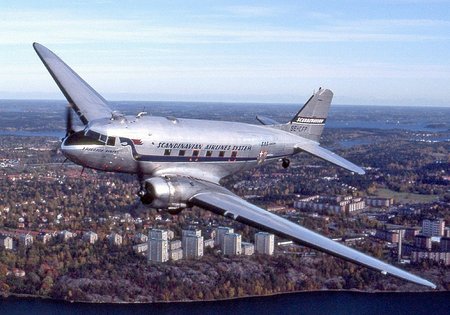Flight DC-3 Disappearance in
Bermuda Triangle
On December 28, 1948, the flight Douglas Dakota DC-3 (NC16002) took off at 10.03p.m. from San Juan airport of Puerto Rico heading for Miami (Florida). While it was only 50 miles south of Florida, it sent the last message to indicate its position. Only 20 minutes to go, the flight was never seen or heard of again.
It disappeared in the Bermuda Triangle area with all its 28 passengers and 3 crew members. This was the first instance of a DC-3 aircraft disappearing. There were subsequently two more such cases, all of them happened within 50 miles of Florida Keys. The Keys is a string of small islands just south of Florida.
Here is the full story of DC-3 / NC16002 disappearing in Bermuda Triangle.
Background of DC-3
(Douglas Dakota)
Douglas Dakota or the DC-3 has been probably the most reliable aircraft ever designed and built. There were more than 10,000 DC-3 planes manufactured, and still hundreds remain in use. These are propeller driven aircraft and not jet planes. The economics and practical consideration have still kept them in use although small jet planes are now gradually replacing them.
Douglas Dakota DC-3
Source: Wikimedia Commons
You will see lots of these aircraft in Florida and also in the whole of Caribbean and Bahamas. Their job is mainly island hopping. Because of small distances between the islands and also short runways, the big jumbo jets are usually unfit for such activities and DC-3 is ideally suited for this. The DC-3 is also widely used as private charter planes by many airlines and also for spraying pest controls from the air, particularly mosquito killers.
The Dreaded Flight of DC-3, NC16002
At 7:40p.m. on 27th December 1948, the DC-3 landed at San Juan airport in Puerto Rico. It came from Miami and was scheduled to return after a short halt at San Juan.
Captain Bob Linquist reported to the ground engineers that the light indicator for the landing gear did not come on at the time of landing. The ground crew immediately started the checks and figured out that the battery was weak and running low on water. The stewardess Mary Burkes was busy deplaning the passengers and the co-pilot Ernest Hill was going around the aircraft for routine checks.
The ground crew refilled the battery and informed the captain that it would take several hours for the batteries to recharge fully. The captain however decided not to wait that long and rather charge the batteries in the air from the aircraft's own generator.
So at 8:30p.m the DC-3 was all set to depart for Miami. By this time, Mary Burkes had on-boarded 28 passengers for the return trip.
However, there was lot more annoying wait before the plane could finally take off. The radio transmitter in the aircraft was not working properly due to the low battery. So the aircraft was asked to wait at the end of the tarmac. The head of Puerto Rican Transport drove to the plane to talk to the captain. Linquist informed him that he could clearly receive the messages but could not every time send messages due to the low battery.
Finally at 10:03p.m. when all seemed to be okay, the flight was allowed to take off. The captain was advised to stay close to San Juan till the two way communication was fully established from the air. The flight circled the San Juan city for 11 minutes, and once the both-way radio communication was confirmed, it started its journey out towards the sea for Miami.
Next, at 11:23p.m, the captain Linquist sent his routine radio transmission to indicate the flight position - it was at 8,300 feet altitude and reported ETA 4.03a.m at Miami. But funnily, while the message was received at Miami control tower which was some 700 miles away, there was no transmission received at San Juan which was much closer.
The captain next reported the flight position when it was 50 miles south of Florida and only 20 minutes to land. Strangely again, the message this time was received at New Orleans which was about 600 miles away and not Miami that was so close by. New Orleans radio tower forwarded the message to Miami station.
And that was the last time a message was ever received from the DC-3. The weather was normal. Repeated radio signals from the control towers did not get any response. The flight DC-3 had suddenly disappeared with all its passengers and crew.
What may have happened to DC-3
An explosion could have explained the aircraft getting disintegrated in the air keeping no trace of anything. No one from near or around Florida had heard any explosion. Also the waters at the Florida Keys area is so shallow (about 20ft) that any debris could easily be seen at the bottom. Even after long extensive search operation, there was nothing found. Hundreds of search planes and ships scoured the entire area, but no trace of the plane could be found.
Many believe that the transmitter of the aircraft was faulty and therefore the captain did not receive a message sent from Miami radio station at 12:15a.m (both Miami and New Orleans radio station confirmed that they were unable to contact the plane). This message was to inform the captain that there was a change in wind direction from North West to North East. Without this information, the plane could have been blown 40 to 50 miles south and off its course by the wind without making the necessary direction adjustments. Then they would have got lost, had run out of fuel and crashed. The gulf stream would have dispersed all the debris and bodies.
This also looks improbable because when the captain last reported its position, it was 50 miles south of Florida. There was no need for the aircraft to go south of Florida to reach Miami. So the captain knew that they had been moved off the course by the wind and would have used the in-flight positioning instrument to fix the position of the flight.
Larry Kusche (the American research librarian, author and a pilot) in his famous book 'The Bermuda Triangle Mystery - Solved' published in 1975, brought in another dimension to the story though his research. He mentioned that in contrary to the legend, the DC-3 was never in contact with the Miami Tower. He quoted that according to December 29 Miami Herald... "The New Orleans station advised district Coast Guard head quarters... The message from the DC-3 was not heard here".
The Civil Aeronautics Board investigation stated that there were insufficient information available to determine the real cause of this loss. One thing for sure... whatever might have happened, had happened suddenly and fast. The real mystery of Douglas Dakota DC-3 remains unsolved to date.
|
 By Raj Bhattacharya By Raj Bhattacharya
Raj, a seasoned travel writer and Bermuda destination expert, has extensive global travel experience. This website reflects his profound insights, garnered over nearly two decades of dedicated findings and research on the island. Raj has assisted countless Bermuda-bound visitors by providing direct, personalized responses to their queries and imparting his wealth of knowledge through this platform. This site serves as an indispensable guide for those seeking informed and reliable insights into Bermuda's treasures.
|
Related Articles
|
Your Reviews
Marcia Hill Wheeler (December 2018)
My father was Ernest E. Hill. I never knew him and reading this information makes me sad. Never having a father created a longing in me that was never satisfied. My mother (his wife) died in 1958 of cancer. I was 11 years old. After that life became very difficult.
|

 By Raj Bhattacharya
By Raj Bhattacharya